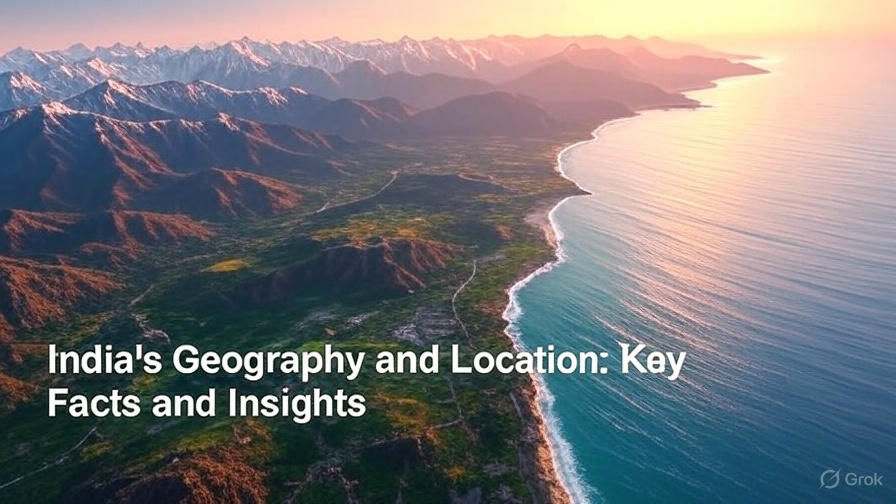India's Geography and Location: Key Facts and Insights

India's Geography and Location: Key Facts and Insights
Introduction
India’s geography and location have made it a unique and influential nation on the global stage. As one of the world’s ancient civilizations, India has thrived for centuries, achieving remarkable progress in agriculture, industry, technology, and socioeconomic development over the last five decades. This blog post dives deep into India’s geography and location, exploring its vast size, strategic position, and historical significance. Whether you’re a student preparing for exams or a geography enthusiast, this guide will provide you with key facts and insights about this incredible country.
Location of India
India is a vast country located entirely in the Northern Hemisphere. Its mainland stretches between latitudes 8°4'N and 37°6'N and longitudes 68°7'E and 97°25'E. The Tropic of Cancer (23°30'N) runs through the country, splitting it into nearly two equal parts. Beyond the mainland, India’s territory extends to the Andaman and Nicobar Islands in the Bay of Bengal to the southeast and the Lakshadweep Islands in the Arabian Sea to the southwest.
Key Geographical Coordinates
- Northernmost Point: 37°6'N
- Southernmost Point: 8°4'N (mainland); Indira Point in the Andaman and Nicobar Islands (submerged in 2004 due to the Tsunami)
- Easternmost Point: 97°25'E
- Westernmost Point: 68°7'E
Interestingly, despite the latitudinal and longitudinal extent both being around 30°, the east-west distance appears shorter than the north-south distance due to the Earth’s curvature.
Size of India
India spans a land area of 3.28 million square kilometers, making it the seventh-largest country globally. This accounts for approximately 2.4% of the world’s total geographical area. Its land boundary stretches 15,200 km, while the total coastline—including the mainland, Andaman and Nicobar, and Lakshadweep—measures 7,516.6 km.
India’s Ranking Among Nations
Countries larger than India include Russia, Canada, China, the USA, Brazil, and Australia. However, India’s size supports an incredible diversity of climates, ecosystems, and cultures.
Time Differences and Standard Meridian
India’s east-west expanse creates a natural time difference of about two hours between Gujarat in the west and Arunachal Pradesh in the east. To maintain uniformity, the Standard Meridian (82°30'E), passing through Mirzapur in Uttar Pradesh, is used as the basis for Indian Standard Time (IST).
India and the World
India’s geography and location place it at a strategic crossroads. Situated centrally between East and West Asia, India extends southward into the Indian Ocean via the Deccan Peninsula. This position has historically enabled trade and cultural exchanges with West Asia, Africa, Europe, and Southeast and East Asia.
Historical Trade and Cultural Exchange
Since ancient times, India’s land routes through northern mountain passes and maritime routes across the Indian Ocean have facilitated the exchange of ideas and goods. The Upanishads, Ramayana, Panchtantra stories, Indian numerals, and spices have reached the world, while Greek sculptures and West Asian architectural styles have influenced India.
Strategic Importance
India’s prominence in the Indian Ocean is so significant that the ocean bears its name. The opening of the Suez Canal in 1869 shortened India’s distance from Europe by 7,000 km, enhancing its global connectivity.
India’s Neighbours
India holds a key position in South Asia, sharing land borders with Pakistan and Afghanistan (northwest), China (Tibet), Nepal, and Bhutan (north), and Myanmar and Bangladesh (east). Across the sea to the south lie the island nations of Sri Lanka and the Maldives.
States and Union Territories
India comprises 28 states and 8 Union Territories. Some states, like Uttarakhand, Uttar Pradesh, Bihar, West Bengal, and Sikkim, share borders with neighboring countries, while others are landlocked or coastal.
Southern Island Neighbours
Sri Lanka is separated from India by the Palk Strait and Gulf of Mannar, while the Maldives lies south of Lakshadweep. These nations share historical and geographical ties with India.
Conclusion
India’s geography and location are not just facts on a map—they are the foundation of its rich history, vibrant culture, and global influence. From its vast size to its strategic position in the Indian Ocean, India stands out as a remarkable nation. This guide has explored key aspects of India’s geography, making it an ideal resource for students and enthusiasts alike.
Call to Action: Want to learn more? Check out related articles on our site or explore map-based learning tools like School Bhuvan, NCERT to deepen your understanding of India’s geography!
Frequently Asked Questions (FAQs)
What is the latitudinal extent of India?
India’s latitudinal extent is from 8°4'N to 37°6'N.
What is India’s total land area?
India covers 3.28 million square kilometers.
Why is 82°30'E the Standard Meridian of India?
It provides a uniform time (IST) across India’s vast east-west expanse.
Which countries are larger than India?
Russia, Canada, China, USA, Brazil, and Australia are larger than India.
What is the length of India’s coastline?
India’s coastline measures 7,516.6 km, including its islands.
Why is India’s location in the Indian Ocean significant?
It enables trade and strategic links with Europe, Africa, and Asia.
Which island groups lie to India’s southeast?
The Andaman and Nicobar Islands lie to India’s southeast.
Which states border Nepal?
Uttarakhand, Uttar Pradesh, Bihar, West Bengal, and Sikkim border Nepal.
Why does the sun rise earlier in Arunachal Pradesh than Gujarat?
Due to India’s east-west extent, but IST standardizes the time nationwide.
Which island countries are India’s southern neighbours?
Sri Lanka and the Maldives are India’s southern neighbours.
Join the conversation